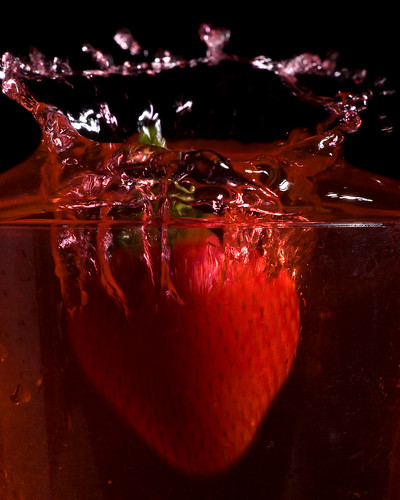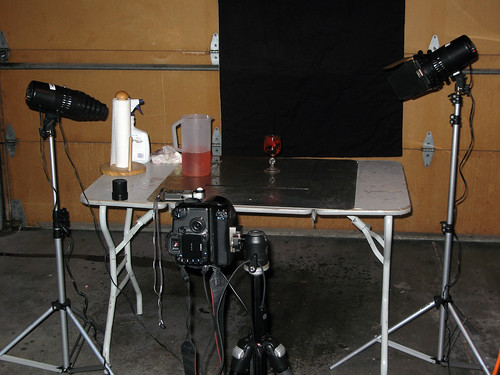How to: High Speed Splash Photography
Yesterday I posted some shots of a strawberry splashing into a drink with a brief explanation of how I did the shot (see the post here). I was really surprised at the amount of email I received asking for more information on how I created the shots. To answer these questions, here is a more detailed explanation of how I created the shots.
Lighting
I use relatively inexpensive studio lights (I purchased a two light set from Adorama for under $300). These lights are fairly low power (guide # 100) but work well on close in shots. Each of the shots was made with one light placed at approximately 85 degrees from the camera. I fire the lights with a sync cable connected to my Canon 30D. If you are using a camera that doesn't have a sync cable port (Canon Rebel for example), you can fire the lights using a hotshoe sync adapter. This relatively inexpensive piece fits on the camera hotshoe and has a place to plug your lighting into. You can also fire the lights via slave from your camera's onboard flash, but this has a tendency to adversely affect your lighting.
On the lights I use either a barndoor or a snoot attachment. This eliminates the light from splashing on the background and the camera lens.
Metering
I use a handheld meter to get a true reading of the lighting output. This step can save quite a bit of time in post processing. If you don't have a handheld meter, bracket a number of shots and then view them on your computer to determine the best exposure.
Camera
My primary camera is a Canon 30D SLR. The great part about using an SLR is the near-immediate shutter release when the button is pushed. Timing is critical in catching the splashes and having a fast acting camera is very nice. I have tried these shots with a point-n-shoot camera. It is a bit trickier to time the shots, but it can be done.
I have the camera on a tripod and use a remote cable release. I drop the strawberry with one hand and fire the camera with the other. When I have a helper (usually a daughter), I have her drop the object while I fire the camera.
I prefer to shoot these shots with a telephoto lens for two reasons. The first being that it creates a narrow depth-of-field and throws the background completely out of focus. Secondly, it keeps the camera clear of the "splash zone".
Background
For a background in these shots, I am just using a black sheet. Like a said earlier, by using the barndoor attachment on the light, I am able to keep the flash off of the background thus making it underexposed and "true black".
Props
I have used several different items in my splash shots. I have dropped cookies into milk, cream into coffee, and as we see here strawberries into strawberry lemonade. In this instance my strawberry lemonade is simply water with food coloring. I try to avoid sugary liquids due to the stickiness it causes on everything it hits (occasional camera/lens included).
Studio
My studio is rather low-tech. This shot shows a typical splash-shot setup in my garage. I have long since lost the privilege of taking these shots in the house due to the mess it creates.
Post Processing
I use Photoshop CS2 (on a Mac) for my processing. These shots required very little work. I converted the image from RAW format using Adobe Camera Raw, then cropped and applied a small amount of sharpening.
Conclusion
As you can see, this is a relatively easy type of photography to do. The fun part is to just be creative. I had one comment questioning the usefulness of these shots. I really don't have a use for them. I sell an occasional splash photo on iStockPhoto, but other then that I just consider it art.
Give it a try and see what you can create.
Labels: tutorial




4 Comments:
If you are using a camera that doesn't have a sync cable port (Canon Rebel for example), you can fire the lights using a hotshoe sync adapter.
According to today's news, Canon is coming out with a new 580EX II which has a sync port. I assume this would be able to be used on the Rebel to add sync capability. Probably more expensive than a hot-shoe adapter though.
I have long since lost the privilege of taking these shots in the house due to the mess it creates.
I haven't... yet. Shhh, we do it after Diane goes to bed, she'll never know. >;->
You Crack me up Harley!!!!
Rich thaks for showing how you do the set up! You never know how simple or complex something is, from here we just see the incredible outcomes.
Ricci
Very interesting!
These are beautiful shots--and I found them because I'm having trouble today capturing similar stuff: http://forums.dpreview.com/forums/read.asp?forum=1036&message=27773331 paste that link into your browser to see my "best" efforts today! lol! I am going out now to buy a black cloth, but what lens are you using (I used a 50-200 mm zoom at 180 mm, about 5 ft away from glass) and set it at f/11, but didn't use anything other than outdoor sunlight. Also--how far away were you--it looks to be about the same distance I used, and what mm were you shooting at? Thanks for your help and the wonderful photos--Cindy
Post a Comment
<< Home